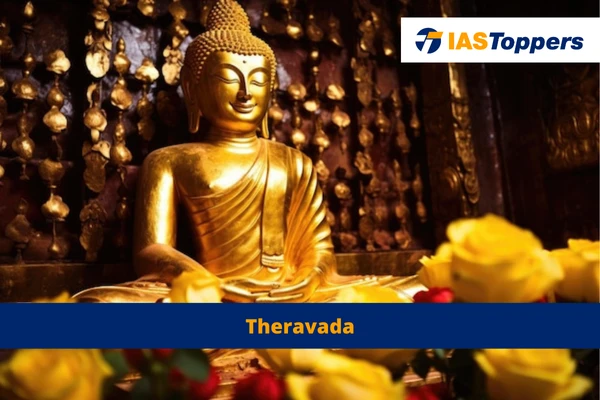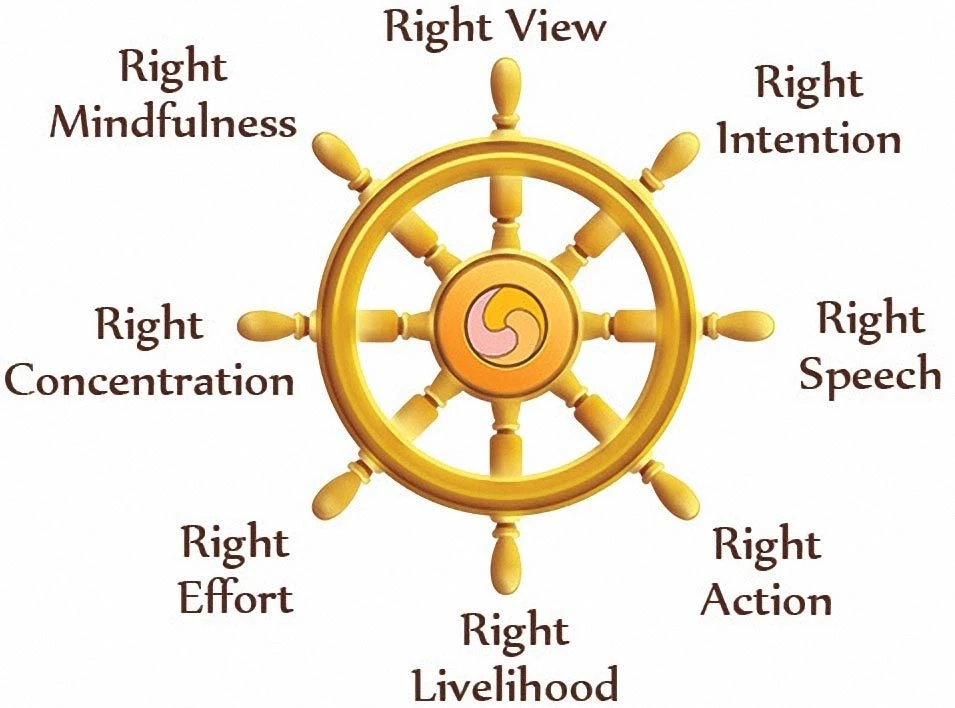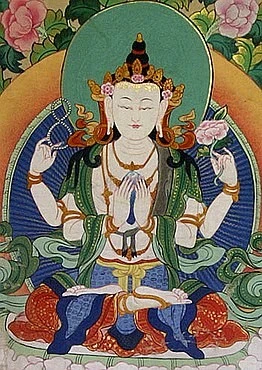Theravada Buddhism is sub sect of Hinayana school of Buddhism which reveres the teachings of the elder monks. In this article, you will learn definition, characteristics of Theravada buddhism, Theravada vs Mahayana vs Vajrayana, texts, festivals, boddhisatvas, etc.
This article will provide key insights for GS Paper- I Art and Culture section of UPSC IAS Exam.
Table of Content
- What is Theravada Buddhism?
- Features of Theravada Buddhism
- Teachings of Theravada Buddhism
- Types of meditation in Theravada Buddhism
- Texts of Theravada Buddhism
- Festivals celebrated by Theravada Buddhism
- Boddhisatvas in Theravada Buddhism
- Monastic life
- What is the difference between Theravada Buddhism, Mahayana Buddhism and Vajrayana Budddhism?
- Conclusion
- Frequently Asked Questions
- Reference
What is Theravada Buddhism?
- Theravada Buddhism is sub sect of Hinayana school of Buddhism which reveres the teachings of the elder monks.
- The term ‘Theravada’ means ‘the teachings of the elders,’ where elder represents the senior Buddhist monks.
- The core doctrinal source for this school is the Pali Canon, which is the only existing complete Buddhist canon.
- It is also known as Sthaviravada or ‘Southern Buddhism’.
- Its followers are expected to refrain from all forms of wrongdoing, do virtuous actions, and focus on purifying their mind.
Features of Theravada Buddhism:
- Pali is the sacred language of Theravada Buddhism.
- Theravada is considered to be a successor to the Hinayana school.
- Theravada is followed in countries such as Sri Lanka, Cambodia, Laos, Thailand, Myanmar (erstwhile Burma), and others.
- The Theravada Buddhists only concentrate on offering ceremonial prayers to the idols of Buddha.
- Under Theravada Buddhism, a person whose aim is to become fully enlightened is still subject to birth, illness, death, sorrow, defilement, and delusion.
Teachings of Theravada Buddhism
- The ultimate aim of Theravada is the cessation of negative mental states, referred to as kleshas, and the attainment of the state of Nirvana.
- Kleshas covers various states of mind such as anxiety, fear, anger, jealousy, desire, and depression.
- The Nirvana can be achieved through the practice of the Noble Eightfold Path, which liberates individuals from the cycle of suffering and rebirth.
- Once a person attains liberation, they are known as Arhat or Arahat or “worthy individual“.
- The destiny of Theravada buddhism is becoming an Arhat or Arahat.
- All individuals shall follow 5 principles:
- Avoid causing harm to living beings
- Refrain from taking what is not freely given
- Abstain from engaging in sexual misconduct
- Avoid engaging in wrong speech, such as lying, gossip, or using harsh language
- Refrain from consuming intoxicating substances that lead to carelessness
- Vibhajjavada means “teaching of analysis,” is a central concept in Theravada Buddhism.
- Vibhajjavada emphasizes the meticulous examination and analysis of teachings.
Noble Eightfold Path:
Types of meditation in Theravada Buddhism
- The Theravada tradition holds that both Samatha and Vipassana are integral to the Noble Eightfold Path, as taught by the Buddha.
- Samatha focuses on calming the mind.
- Vipassana focuses on insight into the three fundamental aspects of existence: impermanence, suffering, and the realization of non-self.
- Vipassana meditation is used to attain deep insight into the true nature of reality.
- The objective of Vipassana is a complete transformation of our perception and understanding of the universe.
- Unlike the temporary changes experienced through Samatha, Vipassana aims for lasting and permanent change.
Texts of Theravada Buddhism
Visuddhimagga
- The Visuddhimagga was written by Buddhaghosa in the 5th Century AD in Sri Lanka.
- The Visuddhimagga explains on the seven stages of purification (satta-visuddhi) to be pursued in order to attain salvation according to Theravada Buddhism.
Udana
- Udana is one of the oldest Theravada (Old School) Buddhist text.
- Udana contains the famous story of “Blind Men and the Elephant”.
Tipitaka:
- Buddha’s teachings were compiled after a Buddhist gathering in Patna in the 3rd century BCE.
- In Sri Lanka, during the 1st century CE, these teachings were recorded in Pali and are referred to as the Pali canon.
- This collection is known as the Tipitaka, meaning “three baskets.” The three sections comprise: Vinaya Pitaka, Sutta Pitaka, Abhidamma Pitaka.
Festivals celebrated by Theravada Buddhism
- Buddha Purnima is celebrated as Vishakha Puja in the Theravada tradition.
- Buddhist New Year is celebrated for three days from the first full moon day in April.
- Magha Puja Day is celebrated to commemorate the Fourfold Assembly formed by Buddha at Sarnath.
- Asalha Puja Day or Dhamma Day commemorates the Buddha’s first teaching: the turning of the wheel of the Dhamma.
- Pavarana Day is celebrated to commemorate the when Buddha had attained the Mahaparinirvana.
Boddhisatvas in Theravada Buddhism:
Avalokitesvara
- Avalokitesvara is one of the three protective deities surrounding Buddha.
- Avalokitesvara is depicted as holding a Lotus flower and thus is also known as Padmapani.
- Avalokitesvara can be found in paintings at Ajanta Caves.
- He is said to embody compassion and actively responding to the world’s suffering.
- In Theravada Buddhism, he is informally known as Lokesvara in Cambodia.
- Avalokitesvara is sometimes depicted as a female.
- Avalokitesvara is believed to incarnate in his holiness the Dalai Lama.
Monastic life:
- In Theravada Buddhism, the majority of monks live within monastic communities, and individuals can join at any age.
- A young monk is known as a samanera, while a fully ordained monk is known as a bikkhu.
- The collective monastic community is known as the sangha.
- Monks and nuns undertake the training of the monastic order also known as the Vinaya, which consists of 227 rules.
- Theravada monks and nuns are prohibited from eating after midday and handling money.
Difference between Theravada Buddhism, Mahayana Buddhism and Vajrayana Budddhism:
Conclusion
Theravada meditation focuses more on Vipassana than Mahayana meditation. Women’s role in Theravada Buddhism is that of Bhikkuni which is equivalent to male monks. Similarities between Theravada and Mahayana Buddhism is that both believes in the Noble Fourfold Truth and the Noble Eightfold Path. Theravada Buddhism in India has declined and are limited to North-East India. The ideal of Theravada Buddhism is to attain the state of the arhat.
Ref:Source-1
| Other Articles in History & Culture | |
| Ajanta and Ellora Caves | Pala Dynasty |
| Jainism in India | Miniature Painting |
| Aryabhatta | Pandya Dynasty |
FAQs (frequently asked questions)
Define Theravada Buddhism.
Theravada Buddhism is sub sect of Hinayana school of Buddhism which reveres the teachings of the elder monks.
Who founded Theravada Buddhism?
Theravada Buddhism states to follow the original teaching off Buddha so Gautam Budddha is the founder of Theravada Buddhism.
Why did Theravada and Mahayana split?
Mahayana Buddhism has split off from Theravada as Mahayana though that Theravada was too self-centered in matters of Nirvana and had lost the true vision of Buddhism.
List four basic differences between Mahayana and Theravada buddhism
Theravada Buddhism aims to break away from the cycle of Samsara while Mahayana Buddhism aims to achieve enlightenment through the teachings of the Buddha. Mahayana choose to stay in Samsara and reincarnate out of compassion for others. In Mahayana Buddhism, Bodhisattvas have greater prominence. Mahayana promotes the enlightenment of all living beings.
What do Theravada Buddhism believe in?
Theravada Buddhism emphasises attaining self-liberation through one’s own efforts that is meditation.
What does Theravada mean?
The term ‘Theravada’ means ‘the teachings of the elders,’ where elder represents the senior Buddhist monks.





